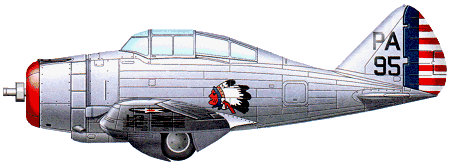 |
Seversky P-351936 |  |
| FIGHTER | Virtual Aircraft Museum / USA / Seversky |
 |
The P-35 marks the debut of Seversky (later Republic) of Farmingdale, Long Island, as a major builder of fighters and introduces the work of the firm's chief designer, Alexander Kartveli. The Seversky P-35 was the first single-seat all-metal pursuit plane with retractable landing gear and enclosed cockpit to go into service with the US Army Air Corps. It was a major step forward, albeit one which was short-lived as war approached. The type began as the company SEV-1XP, one of several machines flown as pursuit prototypes and racers in the 1930s by Major Alexander P. de Seversky, Jacqueline Cochran and others. The P-35 won out over the Curtiss Hawk Model 75 (later P-36) for a 16 June 1936 US Army contract for 77 airframes, powered by the 708kW Pratt & Whitney R-1830-9 Twin Wasp 14-cylinder radial engine. The final airframe in this batch was diverted to become the sole Seversky XP-41. The first P-35 was delivered to Wright Field, Ohio, for tests, and the remaining 75 went initially to the 1st Pursuit Group at Selfridge Field, Michigan. There, the type was received with considerable enthusiasm which lingered even after six machines had been lost in accidents during 1938. Only by later, wartime standards would it become evident that the P-35 was unstable, underarmed, and lacking both armour protection for the pilot and self-sealing fuel tanks. The company EP-106 export variant attracted Sweden's attention and 120 machines were ordered with the Flygvapen designation J9. These were powered by the 783kW Pratt & Whitney R-1830-45 Twin Wasp radial. When President Roosevelt announced his 10 October 1940 embargo on fighter shipments to Scandinavia, only half had been delivered. The remainder were seized by the US Army as the P-35A. P-35A pursuit ships served with various USAAC units, but by late 1941 about 50 were with First Lieutenant Joseph H. Moore's 20th Pursuit Squadron, 24th Pursuit Group, at Clark Field in the Philippines. Second Lieutenant Max Louk wrote to his parents in mid-1941 that the squadron was undergoing 'a very strenuous programme' of flying 'up to eight hours a day' in the P-35A. Incredibly, some P-35As arrived at Clark still painted in Swedish markings and still wore them during the 8 December 1941 Japanese assault, which was synchronised with the attack on Pearl Harbor. Combat The P-35 was flown by a few memorable pilots, including First Lieutenant 'Buzz' Wagner, commander of the 17th Pursuit Squadron, Nichols Field, Philippines, the first American ace of the war. But by December 1941 the type had become dated and inadequate. Pilots of the P-35 started with the disadvantage of an unforgiving mount. 1939 Technical Order No. 01-65 BA-1 had imposed mind-boggling limitations on the P-35, proscribing inverted flight, inverted spins, and outside loops, and similar caveats applied to the slightly more powerful P-35A. Group Captain Christopher Clarkson, the UK's Royal Air Force test pilot on the US east coast in 1940, logged six hours on P-35 variants and utterly rejected the machine for the RAF. Americans in P-35As in the Philippines simply could not stay with or effectively fight the Mitsubishi and Nakajima fighters that swarmed down on them. Some died ignominiously: First Lieutenant Samuel W. Marrett, commander of the 34th Pursuit Squadron at Del Carmen Field, Philippines, was killed 10 December 1941 when an ammunition barge he was strafing exploded beneath him over Lingayen Gulf, Northern Luzon. Swedish pilots guarding their nation's neutrality faced a different problem. Hans Westerberg, flew the J9 (P-35A) and, in 1944, intercepted a crippled American B-24 Liberator struggling away from a target in Germany. "I could just keep speed with the bomber. I closed in to use hand signals to tell him that his crew could land and be interned in Sweden. All of his guns turned towards me and he was an instant away from opening fire before he understood. The problem was that from some angles my P-35A looked exactly like a Focke-Wulf Fw 190."

|  COMPANY PROFILE | ||||||||||||||||||||||||||||||||||||||||||||||||||||||
 |

|

 Dave UK
Dave UK
Построить дом можно и своими руками. Но, сказать по правде - это не будет очень быстро, тем более, если у вас нет достаточного опыта. �'виду отсутствия опыта дом будет строится медленно и возможно допущение определенных ошибок. Лучше доверить строительство профессионалам.
reply